Reading time: 11 min
There was once upon a time a King who had twelve daughters, each one more beautiful than the other. They all slept together in one chamber, in which their beds stood side by side, and every night when they were in them the King locked the door, and bolted it. But in the morning when he unlocked the door, he saw that their shoes were worn out with dancing, and no one could find out how that had come to pass.
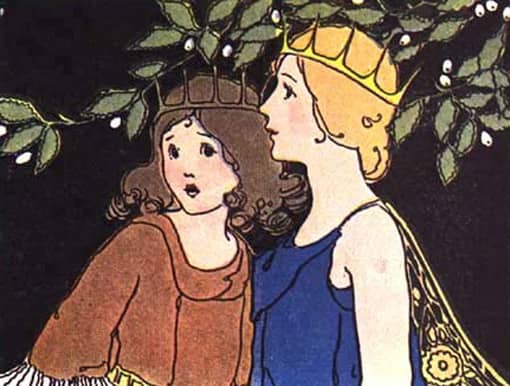
Then the King caused it to be proclaimed that whosoever could discover where they danced at night, should choose one of them for his wife and be King after his death, but that whosoever came forward and had not discovered it within three days and nights, should have forfeited his life. It was not long before a King’s son presented himself, and offered to undertake the enterprise. He was well received, and in the evening was led into a room adjoining the princesses‘ sleeping-chamber. His bed was placed there, and he was to observe where they went and danced, and in order that they might do nothing secretly or go away to some other place, the door of their room was left open. But the eyelids of the prince grew heavy as lead, and he fell asleep, and when he awoke in the morning, all twelve had been to the dance, for their shoes were standing there with holes in the soles.
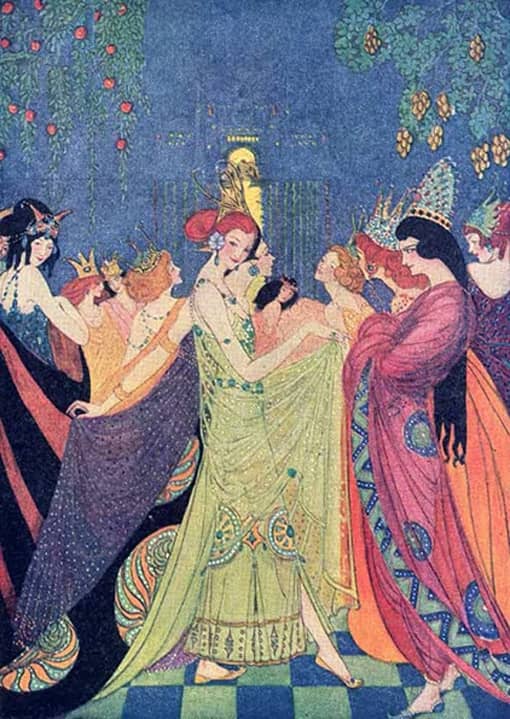
On the second and third nights it fell out just the same, and then his head was struck off without mercy. Many others came after this and undertook the enterprise, but all forfeited their lives. Now it came to pass that a poor soldier, who had a wound, and could serve no longer, found himself on the road to the town where the King lived. There he met an old woman, who asked him where he was going. „I hardly know myself,“ answered he, and added in jest, „I had half a mind to discover where the princesses danced their shoes into holes, and thus become King.“ – „That is not so difficult,“ said the old woman, „you must not drink the wine which will be brought to you at night, and must pretend to be sound asleep.“ With that she gave him a little cloak, and said, „If you put on that, you will be invisible, and then you can steal after the twelve.“ When the soldier had received this good advice, he went into the thing in earnest, took heart, went to the King, and announced himself as a suitor. He was as well received as the others, and royal garments were put upon him. He was conducted that evening at bed-time into the ante-chamber, and as he was about to go to bed, the eldest came and brought him a cup of wine, but he had tied a sponge under his chin, and let the wine run down into it, without drinking a drop. Then he lay down and when he had lain a while, he began to snore, as if in the deepest sleep. The twelve princesses heard that, and laughed, and the eldest said, „He, too, might as well have saved his life.“ With that they got up, opened wardrobes, presses, cupboards, and brought out pretty dresses; dressed themselves before the mirrors, sprang about, and rejoiced at the prospect of the dance. Only the youngest said, „I know not how it is. You are very happy, but I feel very strange. Some misfortune is certainly about to befall us.“ – „Thou art a goose, who art always frightened,“ said the eldest. „Hast thou forgotten how many Kings‘ sons have already come here in vain? I had hardly any need to give the soldier a sleeping-draught, in any case the clown would not have awakened.“ When they were all ready they looked carefully at the soldier, but he had closed his eyes and did not move or stir, so they felt themselves quite secure. The eldest then went to her bed and tapped it. It immediately sank into the earth, and one after the other they descended through the opening, the eldest going first. The soldier, who had watched everything, tarried no longer, put on his little cloak, and went down last with the youngest. Half-way down the steps, he just trod a little on her dress. She was terrified at that, and cried out, „What is that? who is pulling my dress?“ – „Don’t be so silly!“ said the eldest, „you have caught it on a nail.“ Then they went all the way down, and when they were at the bottom, they were standing in a wonderfully pretty avenue of trees, all the leaves of which were of silver, and shone and glistened. The soldier thought, „I must carry a token away with me,“ and broke off a twig from one of them, on which the tree cracked with a loud report. The youngest cried out again. „Something is wrong, did you hear the crack?“ But the eldest said, „It is a gun fired for joy, because we have got rid of our prince so quickly.“ After that they came into an avenue where all the leaves were of gold, and lastly into a third where they were of bright diamonds. He broke off a twig from each, which made such a crack each time that the youngest started back in terror, but the eldest still maintained that they were salutes. They went on and came to a great lake whereon stood twelve little boats, and in every boat sat a handsome prince, all of whom were waiting for the twelve, and each took one of them with him, but the soldier seated himself by the youngest. Then her prince said, „I can’t tell why the boat is so much heavier today. I shall have to row with all my strength, if I am to get it across.“ – „What should cause that,“ said the youngest, „but the warm weather? I feel very warm too.“
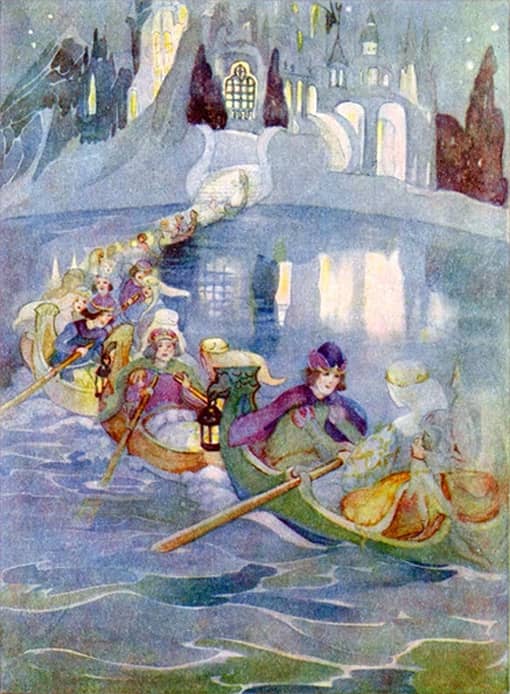
On the opposite side of the lake stood a splendid, brightly-lit castle, from whence resounded the joyous music of trumpets and kettle-drums. They rowed over there, entered, and each prince danced with the girl he loved, but the soldier danced with them unseen, and when one of them had a cup of wine in her hand he drank it up, so that the cup was empty when she carried it to her mouth. The youngest was alarmed at this, but the eldest always made her be silent. They danced there till three o’clock in the morning when all the shoes were danced into holes, and they were forced to leave off. The princes rowed them back again over the lake, and this time the soldier seated himself by the eldest. On the shore they took leave of their princes, and promised to return the following night. When they reached the stairs the soldier ran on in front and lay down in his bed, and when the twelve had come up slowly and wearily, he was already snoring so loudly that they could all hear him, and they said, „So far as he is concerned, we are safe.“
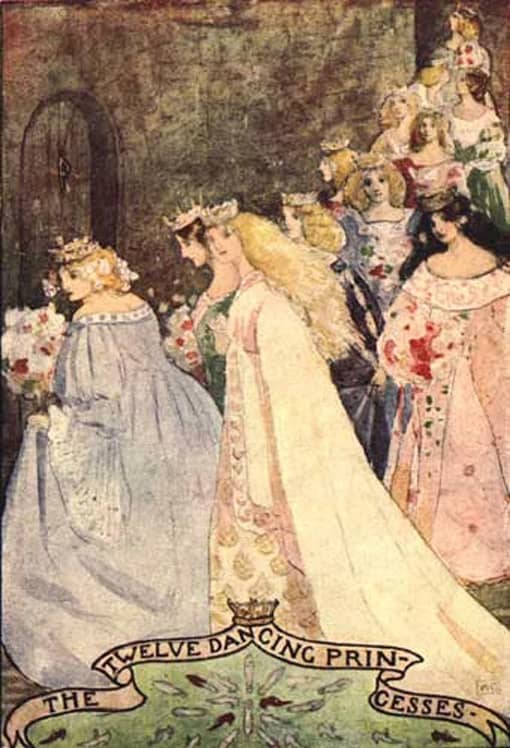
They took off their beautiful dresses, laid them away, put the worn-out shoes under the bed, and lay down. Next morning the soldier was resolved not to speak, but to watch the wonderful goings on, and again went with them. Then everything was done just as it had been done the first time, and each time they danced until their shoes were worn to pieces. But the third time he took a cup away with him as a token. When the hour had arrived for him to give his answer, he took the three twigs and the cup, and went to the King, but the twelve stood behind the door, and listened for what he was going to say. When the King put the question, „Where have my twelve daughters danced their shoes to pieces in the night?“ he answered, „In an underground castle with twelve princes,“ and related how it had come to pass, and brought out the tokens. The King then summoned his daughters, and asked them if the soldier had told the truth, and when they saw that they were betrayed, and that falsehood would be of no avail, they were obliged to confess all. Thereupon the King asked which of them he would have to wife? He answered, „I am no longer young, so give me the eldest.“ Then the wedding was celebrated on the self-same day, and the kingdom was promised him after the King’s death. But the princes were bewitched for as many days as they had danced nights with the twelve.
 Learn languages. Double-tap on a word.Learn languages in context with Childstories.org and Deepl.com.
Learn languages. Double-tap on a word.Learn languages in context with Childstories.org and Deepl.com.Backgrounds
Interpretations
Adaptions
Summary
Linguistics
„The Shoes That Were Danced to Pieces,“ also known as „The Twelve Dancing Princesses,“ is a German fairy tale collected by the Brothers Grimm in their collection, „Grimms‘ Fairy Tales“ (originally titled „Kinder- und Hausmärchen“), published in 1812. The Brothers Grimm, Jacob and Wilhelm, were German scholars who collected and published folklore in an effort to preserve the traditional stories of their homeland. Their work has had a significant influence on literature, inspiring numerous adaptations and retellings over the years.
The tale of the twelve dancing princesses is classified under the Aarne-Thompson-Uther (ATU) classification system as ATU type 306, „The Dancing Princesses.“ This classification system, developed by Finnish folklorist Antti Aarne and later revised by American folklorist Stith Thompson and German folklorist Hans-Jörg Uther, is used to categorize folktales based on their narrative elements and motifs.
In this story, the mysterious nightly disappearance of twelve princesses and their worn-out shoes has been a popular theme in literature, film, and theatre. The tale has numerous variants from different cultures, such as „The Night Dancers“ from Africa, „The Worn-Out Dancing Shoes“ from Norway, and „The Secret Ball“ from France.
The story of the twelve dancing princesses addresses various themes, including curiosity, deception, wisdom, and perseverance. These themes are still relevant today and continue to resonate with readers, making the tale a timeless classic.
„The Shoes That Were Danced to Pieces“ can be interpreted from various angles. Some of the main interpretations include themes of curiosity, deception, wisdom, and perseverance.
Curiosity: The king’s curiosity about his daughters‘ nightly activities leads him to issue the proclamation, sparking a series of attempts to uncover the truth. Similarly, the soldier’s curiosity drives him to take on the challenge and eventually succeed where others have failed.
Deception: The princesses deceive their father by secretly going out to dance each night. They also attempt to deceive the suitors by offering them drugged wine, causing them to fall asleep and fail the challenge. The soldier, however, counters their deception with his own, using the invisibility cloak to follow them unnoticed.
Wisdom and Resourcefulness: The soldier’s success can be attributed to his wisdom and resourcefulness. By listening to the old woman’s advice and using the invisibility cloak effectively, he manages to outsmart the princesses and reveal their secret. This theme suggests that wisdom and resourcefulness can triumph over deception and challenges.
Perseverance: Many suitors try and fail to uncover the princesses‘ secret, losing their lives in the process. The soldier, despite his initial disadvantage as a wounded soldier, perseveres and ultimately succeeds in the challenge. His determination and refusal to give up highlight the importance of perseverance in overcoming obstacles and achieving one’s goals.
Overall, the story of „The Shoes That Were Danced to Pieces“ can be interpreted as a cautionary tale that emphasizes the importance of curiosity, wisdom, resourcefulness, and perseverance in overcoming deception and challenges.
„The Shoes That Were Danced to Pieces“ is a popular fairy tale that has been adapted into various forms of media, including:
Ballet: The story has been adapted into several ballet productions, including the famous ballet „The Red Shoes“ by choreographer Matthew Bourne. This production, which premiered in 2016, tells the story of a young dancer who becomes obsessed with her red ballet shoes and is ultimately driven to madness.
Opera: The tale has also been adapted into operas, including the one-act opera „Die verzauberten Prinzessinnen“ (The Enchanted Princesses) by composer Peter Cornelius.
Film: There have been several film adaptations of the story, including the 1948 film „The Red Shoes“ directed by Michael Powell and Emeric Pressburger, which tells the story of a young ballerina who becomes obsessed with her red ballet shoes.
Picture books: „The Shoes That Were Danced to Pieces“ has been adapted into a number of children’s picture books, including „The Twelve Dancing Princesses“ by Ruth Sanderson and „The Enchanted Princesses“ by Marianna Mayer.
Television: The story has been adapted into episodes of several television shows, including „Faerie Tale Theater“ and „Shirley Temple’s Storybook.“
Theater: „The Shoes That Were Danced to Pieces“ has also been adapted for the stage, including a musical version titled „The Dancing Princesses“ by Matt Conner and Stephen Gregory Smith.
These adaptations often vary in their interpretations of the story and its characters, but all draw on the magical and captivating elements of the original tale.
„The Shoes That Were Danced to Pieces“ is a fairy tale by the Brothers Grimm that tells the story of a king with twelve beautiful daughters who sleep together in a locked chamber. Despite the king’s efforts to prevent them from leaving their room, their shoes are worn out with dancing every morning. The king proclaims that anyone who can discover where they dance at night will marry one of his daughters and inherit the kingdom, but those who fail will lose their lives.
A king’s son tries to uncover the secret but falls asleep and is ultimately beheaded. Many others follow, meeting the same fate. One day, a poor wounded soldier meets an old woman who advises him not to drink the wine offered to him at night and gives him an invisibility cloak. Following her advice, he pretends to sleep while the princesses prepare to go dancing.
The soldier secretly follows the princesses through a series of magical underground passages adorned with silver, gold, and diamond trees. They reach a beautiful castle with twelve princes who dance with the princesses until their shoes are worn out. The soldier takes a few tokens from each passage, including a twig and a cup, as evidence of his adventure.
After three nights, the soldier reveals the secret to the king and produces the tokens. The princesses are forced to confess, and the soldier chooses to marry the eldest daughter. They celebrate their wedding, and the kingdom is promised to him after the king’s death. The princes remain bewitched for as many days as they had danced with the twelve princesses.
The fairy tale „The Twelve Dancing Princesses“ by the Brothers Grimm offers a rich landscape for linguistic analysis, as it reflects the intricate interplay of narrative elements and language use characteristic of traditional folk tales. Here are some notable linguistic features and narrative strategies found in the story:
Formal and Archaic Language: The tale employs a formal and somewhat archaic style, evident in phrases like „There was once upon a time“ and „whosoever could discover. “ This stylistic choice aligns the story with oral storytelling traditions and adds a timeless quality to the narrative.
Repetition and Parallelism: Repetitive structures are a hallmark of fairy tales, serving to reinforce memory and understanding. For instance, the repetition of actions (such as the princesses‘ nightly dances and the consequent wearing out of their shoes) and the soldier’s observant role across the three nights emphasizes the cyclical and ritualistic nature of the story.
Direct Speech and Dialogue: Dialogue is crucial in advancing the plot and revealing character traits. The exchanges between the soldier and the old woman, as well as among the princesses, provide insights into their personalities and motivations. For example, the youngest princess’s sense of foreboding contrasts with the eldest’s dismissive attitude, highlighting their differing perspectives on their secret.
Symbolism and Motifs: The tale is rich with symbols, such as the worn-out shoes symbolizing hidden toil and the magical cloak representing invisibility and discovery. The underground castle and enchanted princes serve as motifs of mystery and enchantment, common in fairy tales to create a sense of wonder and challenge.
Narrative Structure: The structure follows a classic quest narrative, where the protagonist (the soldier) is tasked with uncovering a hidden truth. His journey entails tests and the acquisition of magical aids, culminating in the revelation of the mystery and a consequent reward (marriage and future kingship).
Characterization: Characters are often defined by their actions and roles rather than in-depth psychological portrayal. The soldier is characterized as resourceful and cunning, while the princesses are depicted as mysterious and complicit in their nightly escapades. The use of titles (king, soldier, princesses) rather than personal names reinforces their archetypal roles.
Moral and Theme: Like many fairy tales, this story incorporates a moral element. The narrative rewards cleverness and perseverance (seen in the soldier’s success) while exposing the futility of arrogance and deceit (as seen in the fate of the unsuccessful princes and the confession of the princesses).
Magical Realism: The blend of the ordinary (the King’s court, the soldier) with the fantastical (the invisible cloak, enchanted princes) creates a magical realism that is a staple of fairy tales, allowing readers to explore human experiences through a fantastical lens.
Overall, „The Twelve Dancing Princesses“ uses linguistic techniques and narrative devices that are typical of the Brothers Grimm’s tales, creating a story that is engaging, instructive, and resonant with themes of discovery, justice, and the supernatural.
Information for scientific analysis
Fairy tale statistics | Value |
|---|---|
| Number | KHM 133 |
| Aarne-Thompson-Uther-Index | ATU Typ 306 |
| Translations | DE, EN, EL, DA, ES, FR, PT, HU, IT, JA, NL, PL, RU, TR, VI, ZH |
| Readability Index by Björnsson | 33.8 |
| Flesch-Reading-Ease Index | 78.4 |
| Flesch–Kincaid Grade-Level | 7.8 |
| Gunning Fog Index | 10.7 |
| Coleman–Liau Index | 8.3 |
| SMOG Index | 9.1 |
| Automated Readability Index | 8.8 |
| Character Count | 7.769 |
| Letter Count | 6.031 |
| Sentence Count | 67 |
| Word Count | 1.473 |
| Average Words per Sentence | 21,99 |
| Words with more than 6 letters | 174 |
| Percentage of long words | 11.8% |
| Number of Syllables | 1.847 |
| Average Syllables per Word | 1,25 |
| Words with three Syllables | 71 |
| Percentage Words with three Syllables | 4.8% |
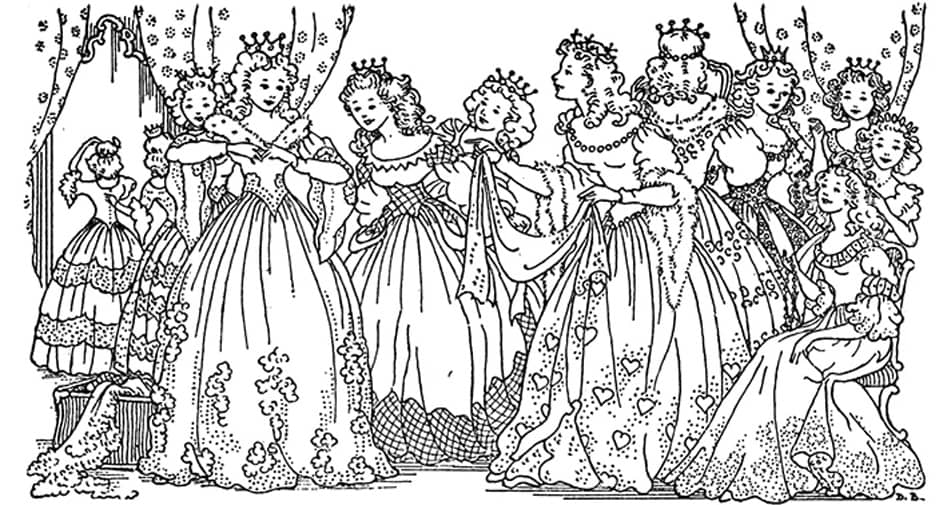
 Facebook
Facebook  Whatsapp
Whatsapp  Messenger
Messenger  Telegram
Telegram Reddit
Reddit













